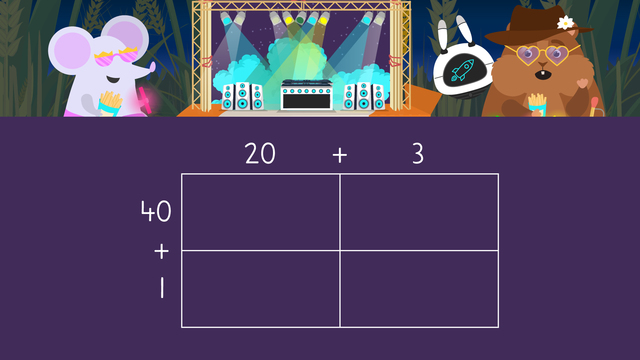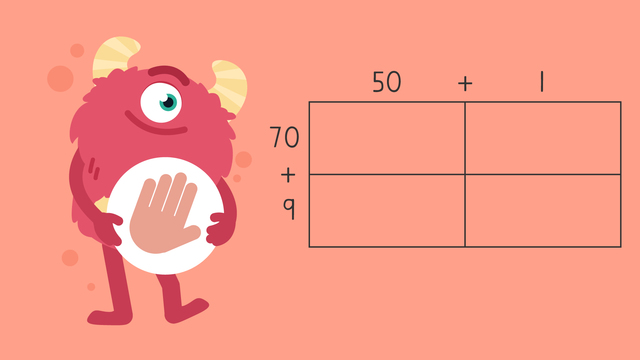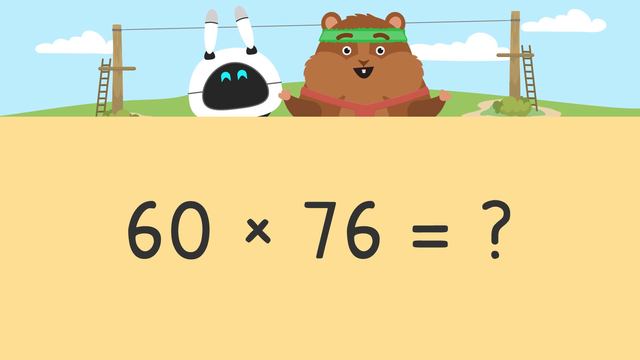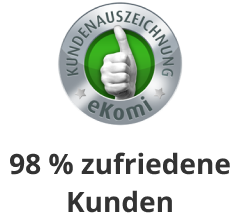Area Model Multiplication up to Three-Digits
- Multiplying a Multi Digit Number with 1-Digit Numbers
- Multiplying a 2-Digit Number with 1-Digit Numbers – Guided Practice
- Multiplying a 3-Digit Number with 1-Digit Numbers – Guided Practice
- Multiplying a Multi Digit Number with 1-Digit Numbers – Summary
- Frequently Asked Questions on How to Multiply a Multi Digit Number with 1-digit Number
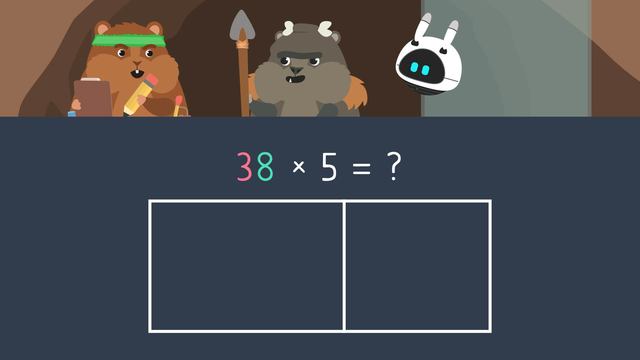
Basics on the topic Area Model Multiplication up to Three-Digits
Multiplying a Multi Digit Number with 1-Digit Numbers
Are you ready to explore the world of multiplication? In this text, we'll delve into the fascinating method of multiplying a 2-digit or 3-digit number by a 1-digit number using an area model. This powerful technique will help you tackle multiplication problems with confidence. Once you learn how to use this method with 2-digit or 3-digit numbers, you will be able to use this method with multi-digit numbers, too!
Multiplying a 2-Digit Number with 1-Digit Numbers – Guided Practice
When you need to multiply a 2-digit number by a 1-digit number, the area model comes to the rescue.
The area model is a visual representation that simplifies the multiplication process.
Let's walk through a step-by-step example to illustrate how it works.
Let’s start with the first example: multiplying 38 by 5
Step 1: Setting up the area model
Begin by drawing a rectangle. Divide the rectangle into segments based on the number of place values in each number. In our example, 38 has two place values (tens and ones), so we split our rectangle into two parts. The number 5, being a 1-digit number, doesn't require further division.
Step 2: labeling the parts
Now, label each part with the expanded form of the factors. On the top, write "30 + 8," representing the number 38. On the left side, write the number 5.
Step 3: Finding partial products
The next step is to multiply each corresponding pair to determine the partial products. These are the results obtained when you multiply each part of one number with each part of the other number.
In our example, we start with the leftmost segment. Multiply 5 by 30 to get 150. Then, multiply 5 by 8, which equals 40.
Step 4: Summing up
To find the final answer, add up the partial products. In this case, the sum of the partial products is 190, which means that 38 multiplied by 5 equals 190.
Multiplying a 3-Digit Number with 1-Digit Numbers – Guided Practice
When you need to multiply a 3-digit number by a 1-digit number, the area model comes to the rescue. Let's walk through a step-by-step example to illustrate how it works.
Let’s look at the following example: Multiplying 245 by 3
Step 1: Setting Up the Area Model
Begin by drawing a rectangle. Divide the rectangle into segments based on the number of place values in each number. In our example, 245 has three place values (hundreds, tens, and ones), so we split our rectangle into three equal parts. The number 3, being a 1-digit number, doesn't require further division.
Step 2: Labeling the Parts
Now, label each part with the expanded form of the factors. On the top, write "200 + 40 + 5," representing the number 245. On the left side, write the number 3.
Step 3: Finding Partial Products
The next step is to multiply each corresponding pair to determine the partial products. These are the results obtained when you multiply each part of one number with each part of the other number.
In our example, we start with the leftmost segment. Multiply 3 by 200 to get 600. Then, multiply 3 by 40, which equals 120. Finally, multiply 3 by 5, resulting in 15.
Step 4: Summing Up
To find the final answer, add up the partial products. In this case, the sum of the partial products is 735, which means that 245 multiplied by 3 equals 735.
Multiplying a Multi Digit Number with 1-Digit Numbers – Summary
In summary, the area model simplifies the process of multiplying a 2-digit or 3-digit number by a 1-digit number. It's a valuable tool for learners of all ages, and with our example and guided practice exercises, you can enhance your multiplication skills effectively.
Remember, when multiplying a multi digit number by a 1-digit number, using area method is easy. You need to follow these steps:
| Step # | What to do |
|---|---|
| 1 | Setting up the area model |
| 2 | Labeling the parts |
| 3 | Finding partial products |
| 4 | Summing up |
For additional resources and exercises, visit our website to find 3 digit by 1 digit multiplication worksheets and more!
Frequently Asked Questions on How to Multiply a Multi Digit Number with 1-digit Number
Transcript Area Model Multiplication up to Three-Digits
What is Mr. Squeaks doing with all those supplies? Oh... Imani needs them to fuel the time machine so they can travel to the Stone Age! Before he gives them to Imani, he needs to calculate how many stones, clocks, and shoes he has. In order to do that, we will practice "Area Model Multiplication up to Three-Digits". An "area model is a rectangular model that helps us find the product of two numbers." Mr. Squeaks has five boxes with thirty-eight clocks in each. Let's help Mr. Squeaks calculate by multiplying thirty-eight times five. The first step is to set up our area model. Start by drawing a rectangle. Next, split it into the number of parts based on how many place values are in each number. Thirty eight has two place values...TENS and ONES, so we split our rectangle in two parts. Five has one place value so we don't break the rectangle into any more parts. Next, label each part by writing the factors in expanded form. The value of the three in the tens place is thirty and the value of the eight in the ones place is eight... so we label the TOP thirty plus eight. Then, we label the five on the LEFT SIDE. The second step is to multiply each corresponding pair to find the partial products. Partial products are the answers we get when each pair of factors is multiplied. In the box on the LEFT, we multiply five times thirty. (...) Remember, you can ignore the zeros at first to get fifteen... and then annex one zero to your answer. Five times thirty equals one hundred fifty. Now we multiply "five times eight" in the box on the RIGHT,(...) which equals forty. After we find all the partial products, the third step is to ADD them. This will give us the answer to our multiplication problem. One hundred fifty PLUS forty is one hundred ninety so (...) they have one hundred ninety clocks. Mr. Squeaks has eight boxes with seventy-six shoes in each. We need to find the product of seventy-six times eight. First, let's set up our area model by drawing a rectangle, (...) breaking it into parts, (...) and labeling it. When we label using expanded form, we have seventy plus six on the TOP and eight on the LEFT. The second step is to multiply each corresponding pair to find the partial products. Let's find the partial product for the box on the LEFT. What is eight times seventy? (...) Eight times seventy equals(...) five hundred sixty. Now let's find the partial product for the box on the RIGHT. Eight times six equals (...) forty-eight. Last, what is the sum of the partial products? (...) Five hundred sixty PLUS forty-eight equals(...) six hundred eight. That means Mr. Squeaks has six hundred eight shoes for the time machine. Last, Mr. Squeaks has three boxes with two hundred forty-five stones in each. We need to find the product of two hundred forty-five times three. The first step is to set up our area model (...) but how does this look with a three-digit number? We still label it using expanded form, (...) but now the model is broken into THREE parts since we are calculating a THREE-digit number. How do we label it? The TOP is labeled using the expanded form two hundred PLUS forty PLUS five... and the three goes on the LEFT. The second step is to multiply to find the partial products. This time, try multiplying on your own. The partial products are six hundred (...) one hundred twenty (...) and fifteen. Now, what do we do with the partial products? The last step is to find the sum of the partial products. (...) The sum of the partial products is seven hundred thirty-five, (...) which is the number of stones Mr. Squeaks has for the time machine. Remember(...) when we solve a multiplication problem using an area model, the first step is to "set up the area model". The second step is to "multiply each corresponding pair to find the partial products". The third step is to "find the sum of the partial products". Let's see if the time machine has enough fuel. It looks like it's working...
Area Model Multiplication up to Three-Digits exercise
-
Can you solve the multiplication problem?
-
Can you complete the area model and solve the problem?
-
Can you spot the mistakes in the area model?
-
Can you find the correct answers to the multiplication problems?
-
Can you complete the area model and find the answer?
-
Can you solve the multiplication problems?



